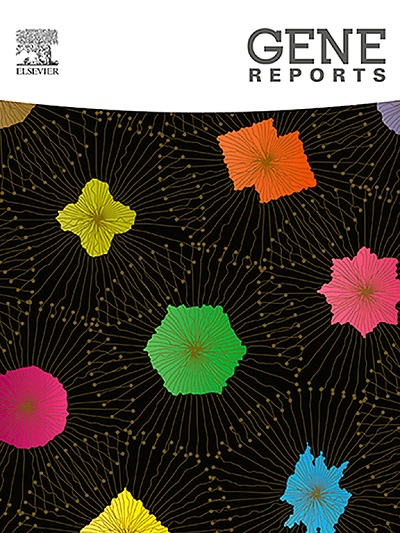Comparative RNA-seq analysis reveals transposable element-mediated transcriptional reprogramming under phosphorus-starvation stress in rice (Oryza sativa L.)
IF 0.9
Q4 GENETICS & HEREDITY
引用次数: 0
Abstract
Phosphorus (P) deficiency hinders crop productivity of 50 % of the rice grown in Asia, Africa, and South America. About 90 % of the phosphate in fertilizers applied to the crops gets fixed in the soil, reducing its availability to plants. This necessitates increased use of phosphatic fertilizers leading to higher cost of cultivation and environmental pollution. Although molecular mechanisms of P-deficiency tolerance in rice are being deciphered, the role of transposable elements (TEs) in transcriptional reprogramming under P-starvation/deficiency stress has not yet been reported. To investigate the role of Pup1 QTL in controlling TE-mediated reprogramming of gene expression, a pair of contrasting rice [Pusa-44 and its Near-Isogenic Line (NIL)-23] genotypes were grown hydroponically under control and stressed (0 ppm Pi) conditions. Comparative RNA-seq analysis of root and shoot tissues from 45-day-old plants of the rice genotypes revealed TE-mediated transcriptional reprogramming affecting biological processes and cellular components. Significantly up-regulated expression of several TEs under P-starvation stress, controlled by Pup1 QTL, particularly in shoots of NIL-23 indicates their crucial role in P homeostasis. Moreover, comparative physio-biochemical analyses confirmed the stress tolerance of NIL-23. Several biological processes including DNA replication/repair, metabolism, signaling, and phosphorylation were modulated through differential (mainly up-regulated) expression of TEs (controlled by Pup1 QTL) in shoots of NIL-23 under P-starvation. To the best of our knowledge, this is a pioneer study on the role of TEs in reprogramming biological processes/molecular functions/cellular components involved in P-use efficiency in rice under stress. The findings advance our understanding of the functions of Pup1 to improve the P-use efficiency/productivity of rice in P-deficient soils.
RNA-seq比较分析揭示磷饥饿胁迫下水稻(Oryza sativa L.)转录重编程的转座元件介导机制
在亚洲、非洲和南美洲,50% 的水稻因缺磷而无法提高产量。施用于作物的肥料中约有 90% 的磷酸盐被固定在土壤中,减少了植物对磷的利用。这就需要增加磷肥的使用量,从而导致种植成本增加和环境污染。虽然水稻耐缺磷(P-deficiency)的分子机制正在被破解,但转座元件(TE)在 P-饥饿/缺磷胁迫下的转录重编程中的作用尚未见报道。为了研究 Pup1 QTL 在控制 TE 介导的基因表达重编程中的作用,在对照和胁迫(0 ppm Pi)条件下水培了一对对比水稻基因型[Pusa-44 及其近交系(NIL)-23]。对水稻基因型 45 天植株根部和芽组织的 RNA-seq 比较分析表明,TE 介导的转录重编程影响了生物过程和细胞成分。在 P-饥饿胁迫下,由 Pup1 QTL 控制的几个 TEs 的表达显著上调,尤其是在 NIL-23 的芽中,这表明它们在 P 平衡中起着关键作用。此外,比较生理生化分析证实了 NIL-23 的抗逆性。在P-饥饿条件下,NIL-23嫩枝中的TEs(由Pup1 QTL控制)通过差异表达(主要是上调)调节了DNA复制/修复、新陈代谢、信号转导和磷酸化等多个生物过程。据我们所知,这是一项关于逆境下 TEs 在重编程水稻 P 利用效率相关生物过程/分子功能/细胞组分中的作用的开创性研究。这些发现加深了我们对 Pup1 在缺钾土壤中提高水稻钾利用效率/生产力的功能的理解。
本文章由计算机程序翻译,如有差异,请以英文原文为准。
求助全文
约1分钟内获得全文
求助全文
来源期刊

Gene Reports
Biochemistry, Genetics and Molecular Biology-Genetics
CiteScore
3.30
自引率
7.70%
发文量
246
审稿时长
49 days
期刊介绍:
Gene Reports publishes papers that focus on the regulation, expression, function and evolution of genes in all biological contexts, including all prokaryotic and eukaryotic organisms, as well as viruses. Gene Reports strives to be a very diverse journal and topics in all fields will be considered for publication. Although not limited to the following, some general topics include: DNA Organization, Replication & Evolution -Focus on genomic DNA (chromosomal organization, comparative genomics, DNA replication, DNA repair, mobile DNA, mitochondrial DNA, chloroplast DNA). Expression & Function - Focus on functional RNAs (microRNAs, tRNAs, rRNAs, mRNA splicing, alternative polyadenylation) Regulation - Focus on processes that mediate gene-read out (epigenetics, chromatin, histone code, transcription, translation, protein degradation). Cell Signaling - Focus on mechanisms that control information flow into the nucleus to control gene expression (kinase and phosphatase pathways controlled by extra-cellular ligands, Wnt, Notch, TGFbeta/BMPs, FGFs, IGFs etc.) Profiling of gene expression and genetic variation - Focus on high throughput approaches (e.g., DeepSeq, ChIP-Seq, Affymetrix microarrays, proteomics) that define gene regulatory circuitry, molecular pathways and protein/protein networks. Genetics - Focus on development in model organisms (e.g., mouse, frog, fruit fly, worm), human genetic variation, population genetics, as well as agricultural and veterinary genetics. Molecular Pathology & Regenerative Medicine - Focus on the deregulation of molecular processes in human diseases and mechanisms supporting regeneration of tissues through pluripotent or multipotent stem cells.
 求助内容:
求助内容: 应助结果提醒方式:
应助结果提醒方式:


